CCNA Implementing and Administering Cisco Solutions v1.0 Course
- 40 Hours
This course helps prepare students to take the 200-301 Cisco Certified Network Associate (CCNA) exam to earn CCNA certification.

About the course
The purpose of CCNA course is to provide a comprehensive foundation in IT for all career paths. It teaches students how to set up, run, configure, and verify a basic IPv4 and IPv6 network. The CCNA course covers configuring network components such as switches, routers, and wireless LAN controllers, managing network devices, and identifying basic security threats. It also provides a foundation in network programmability, automation, and software-defined networking.
Course Objectives
- Identify and describe the components of a computer network and their basic characteristics.
- Understand the process of host-to-host communication.
- Describe the features and functions of Cisco IOS software.
- Explain the role of switches in local area networks (LANs) and describe how Ethernet functions as the network access layer of TCP/IP.
- Install a switch and perform initial configuration.
- Describe the TCP/IP internet layer, IPv4, and its addressing scheme, including subnetting.
- Understand the TCP/IP transport and application layers
- Explore the functions of routing and implement basic configuration on a Cisco router
- Identify and resolve common issues with switched networks and common problems related to IPv4 addressing
- Describe the main features, addresses, and basic IPv6 connectivity, and configure and verify IPv6 connectivity.
- Understand the operation, benefits, and limitations of static routing, and implement and verify VLANs and trunks
- Describe the application and configuration of inter-VLAN routing, and explain the basics of dynamic routing protocols and the components and terms of OSPF.
- Understand how STP and RSTP work and configure link aggregation using EtherChannel.
- Describe the purpose of Layer 3 redundancy protocols, basic WAN and VPN concepts, and the operation of ACLs and their applications in the network.
- Configure internet access using DHCP clients and explain and configure NAT on Cisco routers.
- Understand basic QoS concepts, the concepts of wireless networks, and the types of wireless networks that can be built and how to use WLC.
- Describe network and device architectures and introduce the concept of virtualization.
- Introduce the concept of network programmability and SDN and describe smart network management solutions like Cisco DNA Center, SD-Access, and SD-WAN.
- Configure basic IOS system monitoring tools and describe the management of Cisco devices.
- Understand the current security threat landscape and threat defense technologies.
- mplement basic security configuration of the device management plane and take basic steps to harden network devices.
Course Outline
- EXPLORING THE FUNCTIONS OF NETWORKING
- INTRODUCING THE HOST-TO-HOST COMMUNICATIONS MODEL
- OPERATING CISCO IOS SOFTWARE
- INTRODUCING LANS
- EXPLORING THE TCP/IP LINK LAYER
- STARTING A SWITCH
- INTRODUCING THE TCP/IP INTERNET LAYER, IPV4 ADDRESSING, AND SUBNETS
- EXPLAINING THE TCP/IP TRANSPORT LAYER AND APPLICATION LAYER
- EXPLORING THE FUNCTIONS OF ROUTING
- CONFIGURING A CISCO ROUTER
- EXPLORING THE PACKET DELIVERY PROCESS
- TROUBLESHOOTING A SIMPLE NETWORK
- INTRODUCING BASIC IPV6
- CONFIGURING STATIC ROUTING
- IMPLEMENTING VLANS AND TRUNKS
- ROUTING BETWEEN VLANS
- INTRODUCING OSPF
- BUILDING REDUNDANT SWITCHED TOPOLOGIES (SELF-STUDY)
- IMPROVING REDUNDANT SWITCHED TOPOLOGIES WITH ETHERCHANNEL
- EXPLORING LAYER 3 REDUNDANCY (SELF-STUDY)
- INTRODUCING WAN TECHNOLOGIES (SELF-STUDY)
- EXPLAINING BASICS OF ACL
- ENABLING INTERNET CONNECTIVITY
- INTRODUCING QOS (SELF-STUDY)
- EXPLAINING WIRELESS FUNDAMENTALS (SELF-STUDY)
- INTRODUCING ARCHITECTURES AND VIRTUALIZATION (SELF-STUDY)
- EXPLAINING THE EVOLUTION OF INTELLIGENT NETWORKS
- INTRODUCING SYSTEM MONITORING
- MANAGING CISCO DEVICES
- EXAMINING THE SECURITY THREAT LANDSCAPE (SELF-STUDY
- IMPLEMENTING THREAT DEFENSE TECHNOLOGIES (SELF-STUDY
- SECURING ADMINISTRATIVE ACCESS
- IMPLEMENTING DEVICE HARDENING
